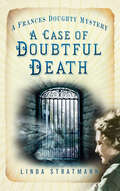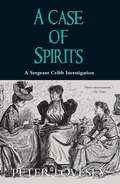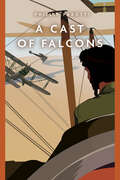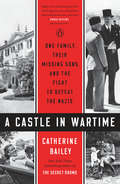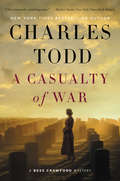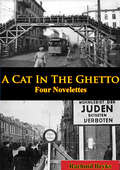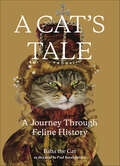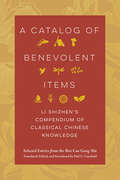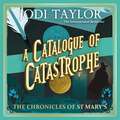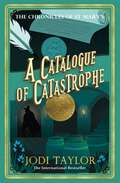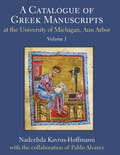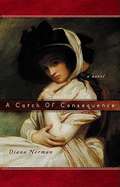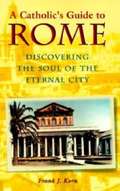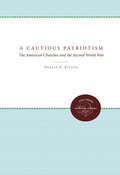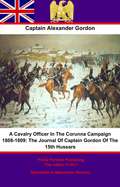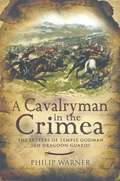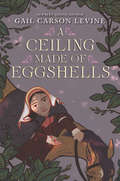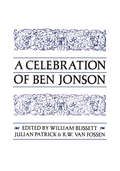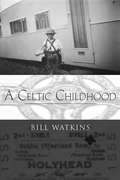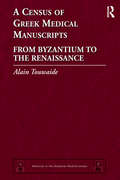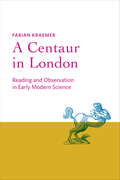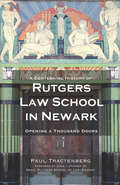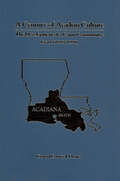- Table View
- List View
A Case of Doubtful Death: A Frances Doughty Mystery 3
by Linda StratmannThe year is 1880. In West London, a dedicated doctor has set up a waiting mortuary on the borders of Kensal Green Cemetery, where corpses are left to decompose before burial to reassure clients that no one can be buried alive. When he collapses and dies on the same night that one of his most reliable employees disappears, Frances Doughty, a young sleuth with a reputation for solving knotty cases, is engaged to find the missing man, but nothing is as it seems. In this, her third case, Frances Doughty must rely on her wit, courage and determination – as well as some loyal friends – to solve the case. Suspicions of blackmail, fraud and murder lead to a gruesome exhumation in the catacombs, with shocking results. The third book in the popular Frances Doughty Mystery series.
A Case of Spirits (Sergeant Cribb #6)
by Peter LoveseyPraise for the Sergeant Cribb series: "Delightful Victorian mysteries, featuring Sergeant Cribb and Constable Thackeray of the Yard. . . . [A] fine picture of period vice, good mystery plotting, and fun."-San Francisco Chronicle. "These are humorous novels and the humor is character-based... Cribb was the first of the new-wave Victorian crime-fighters and is still arguably the best."-Sherlock Holmes Magazine. The spiritualist movement has captivated a segment of society: manifestations, the occult, and 'sensitives' are in vogue. But the séance sites seem to be targeted for burglaries. Then, while Cribb is on the case, someone murders the medium. From the Trade Paperback edition.
A Cast of Falcons (Casemate Fiction)
by Phillip Parotti"Casemate has a long history of publishing high quality military history non-fiction. Lately, they have expanded their range of work to include well written novels using wartime settings." – WWII History MagazineYoung pilots of the Royal Flying Corps take to the air above the Sinai desert in 1916 to fight German pilots flying far superior aircraft. Will their determination and aggressive spirit be enough to prevail?Phillip Parotti’s new novel offers fast-paced action in the skies over the Sinai desert in 1916. Lieutenant Devlin Collins, an Irish-American flier in the Royal Flying Corps, expecting to fly on the Western Front, instead finds himself flying antiquated two-seater bomber and photo reconnaissance missions over the Egyptian desert against the forces of the Central Powers which are trying to capture the Suez Canal. Pitted against German machines which are up-to-date and well equipped, the men of the RFC fight at a considerable disadvantage as they go forth to meet their enemy, but committed to their cause and with aggressive spirit, no matter how great the stress of battle, they proceed and prevail, continually forcing the Turks and Germans back as the army moves slowly toward Palestine. Constantly endangered by superior German machines, facing incessant ground fire during their bombing and strafing attacks, Dev and his fellow pilot Crisp drive home their attacks with unremitting determination. In the off hours from combat, Dev discovers that he has a particular talent for planning his flight’s air raids. This talent manifests itself completely in the campaign’s culminating attack on the German redoubts at the battle of Magdhaba, an attack so successful that when the pilots are finally pulled back for a rest after a year of fighting, Dev is promoted and invited onto the staff at GHQ is order to apply his expertise to air planning as the army moves on Gaza with the intention of driving into Palestine.
A Castle in Wartime: One Family, Their Missing Sons, and the Fight to Defeat the Nazis
by Catherine Bailey"I was gripped by A Castle in Wartime--it contained more tension, more plot in fact--than any thriller."--Kate Atkinson, author of Big Sky and Case HistoriesAn enthralling story of one family's extraordinary courage and resistance amidst the horrors of war from the New York Times bestselling author of The Secret Rooms.As war swept across Europe in 1940, the idyllic life of Fey von Hassell seemed a world away from the conflict. The daughter of Ulrich von Hassell, Hitler's Ambassador to Italy, her marriage to Italian aristocrat Detalmo Pirzio-Biroli brought with it a castle and an estate in the north of Italy. Beautiful and privileged, Fey and her two young sons lead a tranquil life undisturbed by the trauma and privations of war. But with Fascism approaching its zenith, Fey's peaceful existence is threatened when Ulrich and Detalmo take the brave and difficult decision to resist the Nazis.When German soldiers pour over the Italian border, Fey is suddenly marooned in the Nazi-occupied north and unable to communicate with her husband, who has joined the underground anti-Fascist movement in Rome. Before long, SS soldiers have taken up occupancy in the castle. As Fey struggles to maintain an air of warm welcome to her unwanted guests, the clandestine activities of both her father and husband become increasingly brazen and openly rebellious. Darkness descends when Ulrich's foiled plot to kill the Fuhrer brings the Gestapo to Fey's doorstep. It would be months before Detalmo learns that his wife had been arrested and his two young boys seized by the SS. Suffused with Catherine Bailey's signature atmospheric prose, A Castle in Wartime tells the unforgettable story of the extraordinary bravery and fortitude of one family who collectively and individually sacrificed everything to resist the Nazis from within. Bailey's unprecedented access to stunning first-hand family accounts, along with records from concentration camps and surviving SS files, make this a dazzling and compulsively readable book, opening a view on the cost and consequences of resistance.
A Casualty of War: A Bess Crawford Mystery (Bess Crawford Mysteries #9)
by Charles ToddFrom New York Times bestselling author Charles Todd comes a haunting tale that explores the impact of World War I on all who witnessed it—officers, soldiers, doctors, and battlefield nurses like Bess Crawford.Though the Great War is nearing its end, the fighting rages on. While waiting for transport back to her post, Bess Crawford meets Captain Alan Travis from the island of Barbados. Later, when he’s brought into her forward aid station disoriented from a head wound, Bess is alarmed that he believes his distant English cousin, Lieutenant James Travis, shot him. Then the Captain is brought back to the aid station with a more severe wound, once more angrily denouncing the Lieutenant as a killer. But when it appears that James Travis couldn’t have shot him, the Captain’s sanity is questioned. Still, Bess wonders how such an experienced officer could be so wrong. On leave in England, Bess finds the Captain strapped to his bed in a clinic for brain injuries. Horrified by his condition, Bess and Sergeant Major Simon Brandon travel to James Travis’s home in Suffolk, to learn more about the baffling relationship between these two cousins. Her search will lead this smart, capable, and compassionate young woman into unexpected danger, and bring her face to face with the visible and invisible wounds of war that not even the much-longed for peace can heal.
A Cat In The Ghetto, Four Novelettes
by Rachmil Bryks"One should read it in order not to forget."--Eleanor RooseveltFirst published in English in 1959 and long unavailable, Rachmil Bryks's vivid stories portray Jewish life in the Lodz ghetto and at Auschwitz. In a spare and tragicomic style, they illuminate the small and large absurdities that arise at the limits of human endurance--from the cooking of "roast meat" made of cabbage leaves to the predicament of Jews forced to cooperate in the hierarchy of their own annihilation. Deceptively simple and often humorous, these stories nevertheless mirror Bryks's nuanced view of major moral dilemmas of the period: action vs. inaction, preserving dignity vs. survival.--Print Ed.
A Cat's Tale: A Journey Through Feline History
by Paul Koudounaris Baba the CatA “fun, fanciful, and even informative” history of felines as revealed by a very learned tabby with a knack for hunting down facts (People).Since the dawn of civilization, felines have prowled alongside mankind as they expanded their territory and spread the myth of human greatness. And today, cats are peddled on social media as silly creatures here to amuse humans with their antics. But this is an absurd, self-centered fantasy. The true history of felines is one of heroism, love, tragedy, sacrifice, and gravitas. Not entirely convinced? Well, get ready, because Baba the Cat is here to set the record straight.Spanning almost every continent and thousands—yes, thousands—of years, Baba’s complex story of feline survival presents readers with a diverse cast of cats long forgotten: from her prehistoric feline ancestors and the ancient Egyptian cat goddess Bastet to the daring mariners at the height of oceanic discovery, key intellectuals in the Enlightenment period, revered heroes from World Wars I and II, and the infamous American tabbies. Baba, a talented model in addition to a scholar, goes beyond surface-level scratches, pairing her freshly unearthed research with a series of stunning costume portraits to bring history to life.A paws-on journey through the feline hall of fame, with in-depth research and four-legged testaments that will make you rethink who defines history, A Cat’s Tale is a one-of-a-kind chronicle that introduces readers to the illustrious ancestors of their closest companions and shows, once and for all, that cats know exactly what they’re doing.“Almost certainly the most unique cat history book ever published.” —Smithsonian Magazine
A Catalog of Benevolent Items: Li Shizhen's Compendium of Classical Chinese Knowledge
by Li ShizhenDistills ten volumes, four dictionaries, and 1,800 years of knowledge into an authoritative introduction to the Ben cao gang mu. The Ben cao gang mu was the world’s most comprehensive encyclopedia of natural history and medicine when it was published in China in 1593. In fifty-two chapters, the physician Li Shizhen recorded two millennia of medical observations, interpreting the wide-ranging uses of plants, animals, minerals, and artificial substances and including countless verbatim quotations along with his own evaluations. Edited and translated by Paul U. Unschuld, A Catalog of Benevolent Items provides thoughtfully curated selections from the Ben cao gang mu, organized by theme. This anthology offers little-known details of China’s historical knowledge of nature; traditional Chinese medicine and its theoretical foundations; social and cultural facets of ancient Chinese civilization not documented elsewhere; and the information management of a sixteenth-century Chinese scholar.
A Catalogue of Catastrophe: Chronicles of St Mary's 13 (Chronicles of St. Mary's #13)
by Jodi Taylor'Jodi Taylor is quite simply the Queen of Time. Her books are a swashbuckling joyride through History' C. K. MCDONNELL BOOK 13 IN THE INTERNATIONALLY BESTSELLING CHRONICLES OF ST MARY'S SERIESFor fans of Richard Osman's Thursday Murder Club series, Jasper Fforde and Doctor Who.---Finally - finally! - Max has that nice office job she's always wanted. The one with no heavy lifting and no one tries to kill her. Well, one out of two's not bad...Punching well above their weight, Max and Markham set out to bring down a sinister organisation founded in the future - with a suspicious focus on the past.Max's focus is staying alive long enough to reunite with Leon and Matthew, alternately helped and hindered by St Mary's. Who aren't always the blessing they like to think they are.But non-stop leaping around the timeline - from witnessing Magna Carta to disturbing a certain young man with a penchant for gunpowder - is beginning to take its toll. Is Max going mad? Or are the ghosts of the past finally catching up with her? What people are saying about Jodi Taylor: 'Once in a while, I discover an author who changes everything... Jodi Taylor and her protagonista Madeleine "Max" Maxwell have seduced me''This amazing series is anything but formulaic. Just when you think you've got to grips with everything, out comes the rug from under your feet''Addictive. I wish St Mary's was real and I was a part of it''St Mary's stories are the much-anticipated highlight of my year''Jodi Taylor has an imagination that gets me completely hooked''A tour de force'(P) 2022 Headline Publishing Group Ltd
A Catalogue of Catastrophe: Chronicles of St Mary's 13 (Chronicles of St. Mary's #13)
by Jodi Taylor'Jodi Taylor is quite simply the Queen of Time. Her books are a swashbuckling joyride through History' C. K. MCDONNELL BOOK 13 IN THE INTERNATIONALLY BESTSELLING CHRONICLES OF ST MARY'S SERIESFor fans of Richard Osman's Thursday Murder Club series, Jasper Fforde and Doctor Who.---Finally - finally! - Max has that nice office job she's always wanted. The one with no heavy lifting and no one tries to kill her. Well, one out of two's not bad...Punching well above their weight, Max and Markham set out to bring down a sinister organisation founded in the future - with a suspicious focus on the past.Max's focus is staying alive long enough to reunite with Leon and Matthew, alternately helped and hindered by St Mary's. Who aren't always the blessing they like to think they are.But non-stop leaping around the timeline - from witnessing Magna Carta to disturbing a certain young man with a penchant for gunpowder - is beginning to take its toll. Is Max going mad? Or are the ghosts of the past finally catching up with her? What people are saying about Jodi Taylor: 'Once in a while, I discover an author who changes everything... Jodi Taylor and her protagonista Madeleine "Max" Maxwell have seduced me''This amazing series is anything but formulaic. Just when you think you've got to grips with everything, out comes the rug from under your feet''Addictive. I wish St Mary's was real and I was a part of it''St Mary's stories are the much-anticipated highlight of my year''Jodi Taylor has an imagination that gets me completely hooked''A tour de force'
A Catalogue of Catastrophe: Chronicles of St Mary's 13 (Chronicles of St. Mary's #13)
by Jodi Taylor'Jodi Taylor is quite simply the Queen of Time. Her books are a swashbuckling joyride through History' C. K. MCDONNELL BOOK 13 IN THE INTERNATIONALLY BESTSELLING CHRONICLES OF ST MARY'S SERIESFor fans of Richard Osman's Thursday Murder Club series, Jasper Fforde and Doctor Who.---Finally - finally! - Max has that nice office job she's always wanted. The one with no heavy lifting and no one tries to kill her. Well, one out of two's not bad...Punching well above their weight, Max and Markham set out to bring down a sinister organisation founded in the future - with a suspicious focus on the past.Max's focus is staying alive long enough to reunite with Leon and Matthew, alternately helped and hindered by St Mary's. Who aren't always the blessing they like to think they are.But non-stop leaping around the timeline - from witnessing Magna Carta to disturbing a certain young man with a penchant for gunpowder - is beginning to take its toll. Is Max going mad? Or are the ghosts of the past finally catching up with her? What people are saying about Jodi Taylor: 'Once in a while, I discover an author who changes everything... Jodi Taylor and her protagonista Madeleine "Max" Maxwell have seduced me''This amazing series is anything but formulaic. Just when you think you've got to grips with everything, out comes the rug from under your feet''Addictive. I wish St Mary's was real and I was a part of it''St Mary's stories are the much-anticipated highlight of my year''Jodi Taylor has an imagination that gets me completely hooked''A tour de force'
A Catalogue of Greek Manuscripts at the University of Michigan, Ann Arbor
by Pablo Alvarez Nadezhda Kavrus-HoffmannA Catalogue of Greek Manuscripts at the University of Michigan, Ann Arbor is a comprehensive, fully illustrated catalogue of the largest collection of Greek manuscripts in America, including 110 codices and fragments ranging from the fourth to the nineteenth century. The collection, held in the Special Collections Research Center of the University of Michigan Library, contains many manuscripts from Epirus and the Meteora monasteries built on high pinnacles of rocks in Thessaly. Nadezhda Kavrus-Hoffmann has based the manuscript descriptions on the latest developments in the fields of paleography and codicology, including the newest recommendations of the Institute for Research and History of Texts in Paris. The catalogue includes high-resolution plates of all the manuscripts, allowing researchers to compare the entries with other Greek manuscripts around the world. This catalogue contains a trove of fascinating information related to Byzantine culture that will be available for the first time to scholars working on various disciplines of the humanities such as Classical and Byzantine Studies, Art History, Medieval Studies, Theology, and History. This is the first volume of a projected two-volume set. Volume 2, also by Nadezhda Kavrus-Hoffmann, will contain descriptions of remaining Greek manuscripts in the Library’s collection, starting with Mich. Ms. 59 and ending with Mich. Ms. 238, for a total of 53 manuscripts and 8 fragments. Both volumes will have the same format – catalogue entries for each manuscript together with extensive illustrations. The publication date for Volume 2 has not been established.
A Catch of Consequence
by Diana NormanA captivating historical novel from the national bestselling author, as Ariana Franklin, of Mistress of the Art of Death. Makepeace Burke serves Patriots at her late father's tavern on the Boston waterfront in 1765 and hates the redcoats with a vengeance. But even she can't watch an angry mob drown an Englishman. She rescues him and nurses him back to health-and falls in love. In Patriot Boston, hers is an unforgivable sin-made worse by the fact that her Englishman turns out be the aristocratic Sir Philip Dapifer. Philip must smuggle Makepeace aboard a ship bound for London and save her life at the expense of the world she knows. Rich in period detail, bringing the years of colonial rebellion to vivid life, A Catch of Consequence is a stylish novel of Boston and England, and of a woman who defies convention in both worlds.
A Catholic's Guide to Rome: Discovering the Soul of the Eternal City
by Frank J. KornFrank Korn presents an insider's guide to the city. He describes not only the familiar churches, basilicas, and historic places, but also takes travelers on fascinating detours down back alleys to little-known, though very important sites. For both the public and the private Rome, he reveals the legends and traditions associated with each.
A Cautious Patriotism: The American Churches and the Second World War
by Gerald L. SittserWorld War II was a turning point in twentieth-century American history, and its effects on American society have been studied from virtually every conceivable historical angle. Until now, though, the role of religion--an important aspect of life on the home front--has essentially been overlooked. In A Cautious Patriotism, Gerald Sittser addresses this omission. He examines the issues raised by World War II in light of the reactions they provoked among Catholics, Episcopalians, Lutherans, Unitarians, and members of other Christian denominations. In the process, he enriches our understanding of the relationships between church and society, religion and democracy. In deliberate contrast to the zealous, even jingoistic support they displayed during World War I, American churches met the events of the Second World War with ambivalence. Though devoted to the nation, Sittser argues, they were cautious in their patriotic commitments and careful to maintain loyalty to ideals of peace, justice, and humanitarianism. Religious concerns played a role in the debate over American entry into the war and continued to resurface over issues of mobilization, military chaplaincy, civil rights, the internment of Japanese Americans, Jewish suffering, the dropping of the atomic bomb, and postwar planning.Originally published in 1997.A UNC Press Enduring Edition -- UNC Press Enduring Editions use the latest in digital technology to make available again books from our distinguished backlist that were previously out of print. These editions are published unaltered from the original, and are presented in affordable paperback formats, bringing readers both historical and cultural value.
A Cavalry Officer In The Corunna Campaign 1808-1809: The Journal Of Captain Gordon Of The 15th Hussars
by Captain Alexander GordonThis ebook is purpose built and is proof-read and re-type set from the original to provide an outstanding experience of reflowing text for an ebook reader. Captain Gordon led a troop of the 15th Hussars during the first of the British army's campaigns into Spain, commanded by Sir John Moore. Unearthed and published many years after it was written by the esteemed Regimental historian Colonel Wylly, his diary bears testimony to the events of the retreat to Corunna. Gordon writes of his adventures with verve, wit and in some places a little venom when talking of his erstwhile commander Moore; he is fulsome in his description of the Portuguese and Spanish people to whom the British had come to aid. For example when relating the qualities of a local wine he could "only compare the taste of it to a mixture of vinegar and ink" On military matters he is no great respecter of rank, and distributes blame and praise where he believes they should be rightly apportioned. He gives a great first-hand account of the famed skirmish of Sahagun, to which he believes started a moral ascendancy of the British cavalry over their French counterparts. Despite some defective equipment and, as Gordon attributes it, dilatory conduct by the commander, he reaches Corunna unlike a number of his comrades and fellow country-men. A fine read, which despite its format as a journal retains some pace, it gives a great view of the retreat from an expert military eye. Text taken, whole and complete from the 1913 edition, John Murray, London Original -238 pages Author - Captain Alexander Gordon (1781-1872) Editor - Colonel Harold Carmichael Wylly (1858-1932) Illustrations - 1 portrait, 2 plans, 1 map not included because of size [A3] Linked TOC
A Cavalryman in the Crimea: The Letters of Temple Godman, 5th Dragoon Guards
by Philip WarnerAmong the British troops bound for the Black Sea in May 1854 was a young officer in the 5th Dragoon Guards, Richard Temple Godman, who sent home throughout the entire Crimea campaign many detailed letters to his family at Park Hatch in Surrey. Temple Godman went out at the start of the war, took part in the successful Charge of the Heavy Brigade at Balaklava and in other engagements, and did not return to England until June 1856, after peace had been declared. He took three very individual horses and despite all his adventures brought them back unscathed.Godmans dispatches from the fields of war reveal his wide interests and varied experiences; they range from the pleasures of riding in a foreign landscape, smoking Turkish tobacco, and overcoming boredom by donning comic dress and hunting wild dogs, to the pain of seeing friends and horses die from battle, disease, deprivation and lack of medicines.He writes scathingly about the skein of rivalries between the Generals (a good many muffs among the chiefs), inaccurate and highly coloured newspaper reports and, while critical of medical inefficiency, regards women in hospitals as a sort of fanaticism. Yet at other times he will employ the pen of an artist in describing a scene, or wax eloquent on the idiosyncrasies of horses. He is altogether a most gallant and sensitive young cavalryman, and deservedly went on to achieve high rank after the war. Always fresh and easy to read, his letters provide an unrivalled picture of what it was really like to be in the Crimea.
A Ceiling Made of Eggshells
by Gail Carson LevineIn A Ceiling Made of Eggshells, Newbery Honor-winning author Gail Carson Levine tells a moving and ambitious story set during the expulsion of Jews from Spain, about a young Jewish girl full of heart who must play her own role in her people’s epic history—no matter the sacrifice. Surrounded by her large family, Loma is happy living in the judería of Alcalá de Henares, Spain, and wants nothing more than to someday have a family of her own. Still, when her intimidating grandfather, her Belo, decides to bring her along on his travels, she’s excited to join him. Belo has the ear of King Ferdinand and Queen Isabella, and Loma relishes her adventures with him, adventures that are beyond the scope of most girls of the time. She soon learns just how dangerous the world is for the Jews of Spain, and how her grandfather’s influence keeps their people safe. But the older Loma gets, the more she longs to realize her own dreams—if Belo will ever allow her to leave his side.
A Celebration of Ben Jonson
by William F. Blissett Julian Patrick R.W. Van FossenThe papers in this volume were given by some of the world's foremost Jonsonian scholars at a conference at the University of Toronto which marked the 400th anniversary of his birth. Each contributor came from a different institution, and Canada, the United States, Great Britain, and New Zealand were represented. The balance of papers likewise reflects the range of Ben Jonson's achievement and the combination of brio and control so characteristic of him.The papers arrange themselves in pairs: 'The Incredibility of Jonsonian Comedy,' as discussed by Professor Clifford Leech, is of a piece with distrust and defiance of the audience as discussed in the paper 'Jonson and the Loathèd Stage' by Professor Jonas Barish; Professor George Hibbard in 'Ben Jonson and Human Nature' and Professor D.I. McKenzie in 'The Staple of News and the Late Plays' offer critical assessment of plays, the one wide-ranging, the other closely focused on a previously neglected play; and Professor H.N. Maclean in '"A More Secret Cause": The Wit of Jonson's Poetry' and Professor L.C. Knights in 'Ben Jonson: Public Attitudes and Social Poetry' approach the difficult and rewarding task of defining Jonson's poetry of appraisal in different but complementary styles.
A Celtic Childhood
by Bill WatkinsThis first volume of a planned trilogy of memoirs reflects upon the boyhood years of Bill Watkins. The stories take place in Limerick and Wales and are told largely through dialogue. This volume includes a glossary of words and phrases. Watkins also provides the lyrics of some traditional songs.
A Census of Greek Medical Manuscripts: From Byzantium to the Renaissance (Medicine in the Medieval Mediterranean #6)
by Alain TouwaideManuscripts containing Greek medical texts were inventoried by author and work at the beginning of the 20th century by a group of philologists under the direction of Hermann Diels. Useful as it was - and will continue to be – Diels’ catalogue omitted authors and works, misidentified manuscripts, and overlooked codices. Furthermore, since the publication of the catalogue, some libraries have adopted a new system of classification, manuscripts have been destroyed, items have changed location, and new ones have come to light. The present Census is a checklist of the Greek medical manuscripts currently known in collections worldwide. It is both an amended and updated index of Diels’ catalogue, and a list of the items missed or overlooked in Diels, or located since. Although it does not supersede Diels’ catalogue, it is the indispensable instrument for a New Diels, and will be the reference for years to come for any new critical edition and medico-historical research based on manuscripts, besides providing the basis for a broad range of other historical inquiries, from codicology to the history of medicine and science, including Byzantine intellectual history, Renaissance studies and humanism, history of the book and early printing, and the history of medical philology and learning.
A Centaur in London: Reading and Observation in Early Modern Science (Information Cultures)
by Fabian KraemerA nuanced reframing of the dual importance of reading and observation for early modern naturalists.Historians traditionally argue that the sciences were born in early modern Europe during the so-called Scientific Revolution. At the heart of this narrative lies a supposed shift from the knowledge of books to the knowledge of things. The attitude of the new-style intellectual broke with the text-based practices of erudition and instead cultivated an emerging empiricism of observation and experiment. Rather than blindly trusting the authority of ancient sources such as Pliny and Aristotle, practitioners of this experimental philosophy insisted upon experiential proof. In A Centaur in London, Fabian Kraemer calls a key tenet of this master narrative into question—that the rise of empiricism entailed a decrease in the importance of reading practices. Kraemer shows instead that the early practices of textual erudition and observational empiricism were by no means so remote from one another as the traditional narrative would suggest. He argues that reading books and reading the book of nature had a great deal in common—indeed, that reading texts was its own kind of observation. Especially in the case of rare and unusual phenomena like monsters, naturalists were dependent on the written reports of others who had experienced the good luck to be at the right place at the right time. The connections between compiling examples from texts and from observation were especially close in such cases. A Centaur in London combines the history of scholarly reading with the history of scientific observation to argue for the sustained importance of both throughout the Renaissance and provides a nuanced, textured portrait of early modern naturalists at work.
A Centennial History of Rutgers Law School in Newark: Opening a Thousand Doors
by Paul TractenbergFounded in 1908 as New Jersey Law School, Rutgers School of Law, Newark possesses a distinctive spirit of excellence, opportunity and innovation. From the beginning, the school welcomed women and the children of immigrants. For the past forty years, its student body has embraced racial, ethnic and socioeconomic diversity, literally changing the face of the legal profession. Rutgers Law has pioneered clinical legal education, instilled in its students a commitment to social justice and public service and counted numerous top scholars and practitioners among its faculty. Not infrequently in its first one hundred years, Rutgers Law has overcome societal, governmental and economic upheavals. Now, new challenges confront it. Distinguished professor of law Paul Tractenberg chronicles the first century and looks with optimism to the future.
A Century Of Acadian Culture, The Development Of A Cajun Community: Erath 1899–1999
by Curney J. Dronet"The study of regionalism," writes anthropologist William R. Ferris, "is the study of the relation between people and the places in which they live." This book explores the history of the area located in Louisiana�s "French triangle," detailing the history of the people who migrated to the area, including the colonial French, Germans, Acadians, refugees from Santo Domingo, and immigrants from the French Revolution. Erath, chartered in 1899, typified many of the small rural towns in Louisiana. The first settlers moving to Erath arrived in 1781. Originally a project of the Acadian Heritage and Cultural Foundation, A Century of Acadian Culture follows the town from its early years through its development into a center of Cajun heritage. This history is anthropological in that it traces the development from wilderness to modern town, while in its coverage of the families who live there, it remains a fascinating work of history.
A Century Of Giants, A.D. 1500 To 1600: In An Age Of Spiritual Genius, Western Christendom Shatters (The Christians: Their First Two Thousand Years #Vol. 9)
by Ted Byfield Society to Explore Record Christian History StaffThe Christians is the history of Christianity, told chronologically, epoch by epoch, century by century, beginning at Pentecost and concluding with Christians as we find ourselves in the twenty-first century. It will consist of approximately twelve volumes, produced over a 10-year period at the beginning of the third Christian millennium. It is written and edited by Christians for Christians of all denominations. Its purpose is to tell the story of the Christian family, so that we may be knowledgeable of our origins, may well know and wisely profit from the experiences of our past both good and bad, and may find strength and inspiration to face the challenges of our era from the magnificent examples set for us by those who went before.
